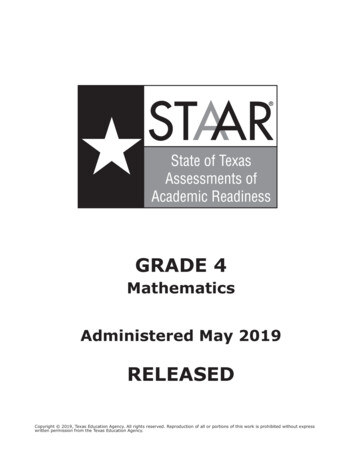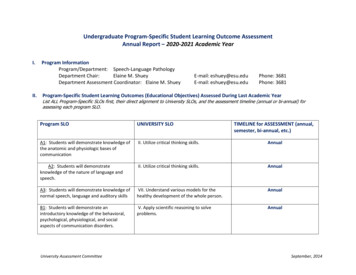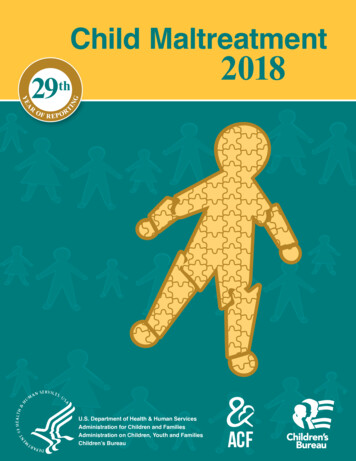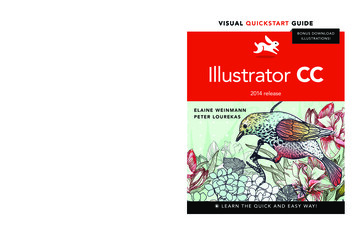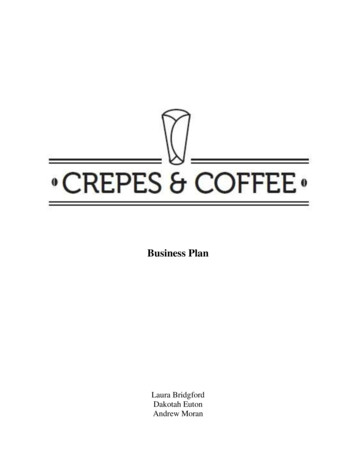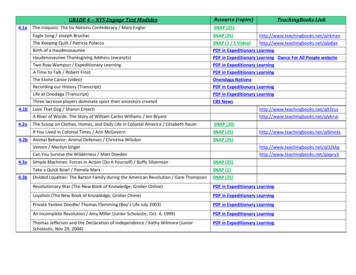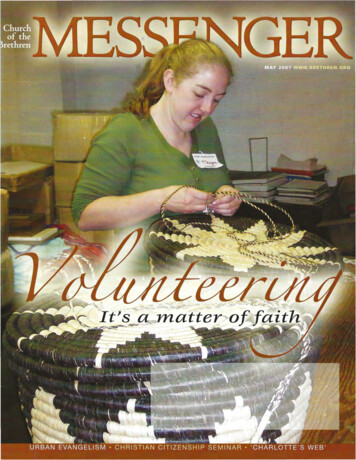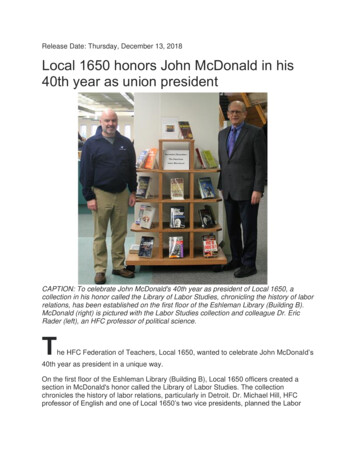
Transcription
EDAD 554.03W and .04WLeading the Learning Community:CapstoneCOURSE SYLLABUS: SPRING 2013Professor:Office Location:Office Hours:Office Phone:Office Fax:University Email Address:Elaine L. Wilmore, Ph. D.RemoteOnline - RemoteNA903.886.5507Elaine@elainewilmore.comHome Phone: 817.641.5254Elaine.wilmore@tamuc.eduCOURSE INFORMATIONMaterials – Textbooks, Readings, Supplementary Readings:Textbook(s) Required:American Psychological Association. (2009). Publication manual of the American psychological association (6th ed.). Washington, D.C.:American Psychological Association.1
Vornberg, J., Hickey, W. D., Borgemenke, A. (Eds.) (2013). Texas public school organization and administration. Duburque, IA: KendallHunt Publishing Company.AWalsh, J. & Kemerer, F., and Maniotis, L. (2010). The educator’s guide to Texas school law (7th ed.) Austin, TX: The University of TexasPress.Wilmore, E. L. (2003). Passing the principal TExES exam: Keys to certification and school leadership. Thousand Oaks, CA: Corwin.Other suggested readings and available websites will be provided during the course.Textbook(s) Recommended:Gorton, R. & Alston, J. (2009). School leadership and administration (8th ed.). Boston, MA: McGraw-Hill Companies.Senge, P. (1999). The fifth discipline. San Francisco, CA: Jossey-Bass.Collins, J. & Porras, J. (1997). Built to last: Successful habits of visionary companies. New York, NY: HarperCollins Publishers.Collins, Jim. (2001). Good to great. New York, NY: HarperCollins Publishers.Collins, Jim. (2005). Good to great and the social sectors (A monograph to accompany Good to Great). Boulder, CO: Jim Collins.Collins, Jim. (2009). How the mighty fall: And why some companies never give in. New York, NY: HarperCollins Publishers.Course Description:This is the capstone course that develops candidates for school leadership who have the knowledge, dispositions, and performance ability topromote success of all students by exercising visionary, collaborative, instructional, organizational, and political leadership. The focus of thecourse is facilitating the development, articulation, implementation, and stewardship of a school vision of learning that is shared by theschool community by exercising highly integrated, transformational, and transactional leadership roles for transforming schools intolearning communities. Prerequisites: Departmental Approval Required. Co-requisite: EDAD 614. (TAMU-Commerce 2012 – 2013,2
Graduate Catalog;http://catalog.tamucommerce.edu/search advanced.php?cur cat oid 16&search database Search&search db Search&cpage 1&ecpage 1&ppage 1&spage 1&tpage 1&location 33&filter%5Bkeyword%5D 607).This course is a requirement for the principal certificate and master’s degree programs.Course Objectives:Through the activities of TAMU-C Principal Preparation Program and this course, students are prepared to be competent administrators inthe following areas: Leadership and campus culture,Values and ethics of leadership,Instructional leadership and management,Human resources leadership and management,Communication and community relations,Organizational leadership and management, andCurriculum planning and management.This course, in particular, is intended to assist students in gaining the professional knowledge and skills needed to: Model and promote the highest standards of conduct, ethical principles, and integrity in decision-making.Analyze a variety of educational administration positions and functions and the influence each has had on the organization andoperation of the school and the district.Serve as skilled group leaders, facilitators, and members; as public speakers; and as writers.Understand the components of organizational culture, models for culture building and change, and the role of the leader in creating,transforming, and sustaining culture in an organization.Define the components of effective school-based decision-making and describe the policies of SBDM in Texas.Define the multiple dimensions and necessary skills of campus improvement that lead to increased student achievement.In addition, students will be challenged and expected to:3
Think critically about roles and responsibilities of effective principals;Engage in reflective thinking about roles and responsibilities of effective principals;Integrate a variety of ideas regarding roles and responsibilities of effective principals, including the active exploration andassimilation of new ideasBe able to synthesize the coursework into a meaningful framework of understanding about roles and responsibilities of effectiveprincipals, including exploration, assimilation, and demonstration of new perspectives, andEncounter and develop solutions to a real-world, realistic problem situation.Student Learning Outcomes:Student learning outcomes are what students are able to do as a result of the activities, readings, instruction, etc., that have occurred in thecourse—these are my expectations of you in terms of academic production and are a concrete representation of the objective stated above.Learning Outcome #1:The learner will be an active and engaged participant in the class proceedings. Students will demonstrate their participation by engaging indiscussions, asking and answering questions, engaging in class activities and group projects, and staying on task.Learning Outcome #2:The learner will think critically; engage in reflective thinking; actively integrate a variety of ideas, including the active exploration andassimilation of new ideas; and synthesize the coursework into a meaningful framework of understanding, including exploration,assimilation, and demonstration of new perspectives. Students will demonstrate these behaviors by analyzing a case, and by means of apresentation, engaging the class in a meaningful discussion of the issues and potential solutions.Learning Outcome #3:The learner will think critically; engage in reflective thinking; actively integrate a variety of ideas, including the active exploration andassimilation of new ideas; synthesize the coursework into a meaningful framework of understanding, including exploration, assimilation,and demonstration of new perspectives; and develop solutions to a real-world, realistic problem. Students will demonstrate these behaviorsby working in a collaborative group to create, organize, and produce a campus case study portfolio that illustrates the learning in the courseas well as learning from the Principal Preparation Program.4
Learning Outcome #4:The learner participates in academic-based, qualitative research. Students will demonstrate this behavior by engaging a lead principal in aninterview, transcribing the interview, and submitting the interview transcription and findings to the professor and classmates.COURSE REQUIREMENTSInstructional / Methods / Activities AssessmentsInstructional Overview:The professor will create an environment for learning by providing focus and guidance to the content. Assignments are designed to belearning experiences for students, and it is presumed and expected that students will actively participate in the class. This is a web-enhancedcourse and some elements of learning will be provided at TAMU eCollege. As a graduate level course, the professor expects quality workfrom each student supported by adequate preparation and involvement. Learning will be achieved through textbook and other assignedreadings, projects and class interaction. This course is made up of a series of assignments and assessments to assist you in achieving thecourse learning outcomes. Each week you will work on various combinations of activities, discussions, readings, research, etc. Evaluationwill be based upon successful completion of each of the performance expectations. Each expectation has been assigned points toward thetotal upon which the final course grade will be assigned.Design of the Class:This class is designed on constructivist principles. This means that the professor creates an environment for learning by providing focus andguidance to the content. Assignments are designed to be learning experiences for students, and it is presumed and expected that studentsactively participate in the class through the construction of their own learning. As a graduate level course, the professor expects quality workfrom each student supported by adequate preparation and involvement.Class Participation:This course utilizes an interactive constructivist approach. In order to maximize the learning experience all students will participate fully inevery activity and assignment. The web-based course will consist of several learning activities including, but not limited to, small & largegroup discussion, student-led learning activities, lecture notes and clarification, reflection activities, individual learning activities, writtenpapers, and reflective, integrative examinations. In order for the class to be interesting and beneficial, each student is expected to have5
recorded weekly minutes in the eCollege portal. The eCollege reports these minutes to the professor. In certain circumstances if a student is(inactive) for “0” recorded minutes, they can be dropped from the course.Students must be prepared to lead and enter into discussions, to ask relevant questions, and to share the results of their studies, experiences,and reflections. This means that each student should be:(1) conscious of the class schedule and the requirements for each week (knowing what to be prepared for),(2) self-disciplined (spending time to be fully prepared; time management;), and,(3) eager to share with your classmates (participating actively by sharing what you have prepared).Class Environment and Professionalism:Education is both a professional endeavor and a people business. If we call ourselves professionals, then we must act accordingly. Pleaseremember this as you prepare for and participate in class. Always practice courtesy, respect the opinions of others, be positive in speech andeffort, encourage your classmates, respect confidentiality, and support each other’s learning. If and/or when you make presentations inEDAD 554, please plan ahead to have it in by the due date. Unless I have given prior written permission, late work will not be accepted.Course Methods and Assignments:Discussion Boards, Weekly Assignments, and Participation:Each class will be made up of several learning activities that will include discussion boards as higher-order reflective activities. Eachstudent is expected to participate in discussions, to ask relevant questions, and to share the results of their study and reflectionutilizing higher-order thinking skills. This means that each student should be conscious of the class schedule and prepared to sharewith classmates in conversation and activities.Each student is expected to participate through E-College, complete all reading and written assignments on time, and actively engagein class by closely connecting class topics and discussions to textbook and other readings. Students will participate in online6
discussions at least once each week by responding to prompts and responding to the answers of others. Students will contribute tocourse and personal goals through sharing meaningfully and implementing higher order thinking skills.Students will read, analyze, and respond to the issues of the week, questions, and comments from others. Topics are related to thereadings, external resources, and activities. Students are required to actively participate in classroom discussions online. You mustdo more than complete assignments; you must demonstrate regular reading and reflection of others’ responses. The professor will belooking for evidence that students are active participants in the learning experience. This can be done by relating real worldexperiences or summaries, building on others’ comments with alternative solutions, pointing out problems, or adding otherdimensions to the discussion. Saying, “I agree” does not fall within the above parameters. Responses should be substantial (i.e. notone sentence). Contributions will be graded for quality, depth, and timeliness of your contributions. No late work will be acceptedfor discussion boards.Principal Interview:Each student will individually interview a lead principal and share the results of the interview with the class.The purpose of this assignment is: to gain insight from practicing principals on the role of actually being a principal, to learn the benefit of developing relationships with other principals in order to draw on their experiences and advice.To complete the interview, students will: Identify the principal to be interviewed. You should select a lead principal of your campus (or another campus) and getpermission to conduct the interview. If your principal will not agree to be interviewed, you will need to seek out a principalfrom another campus. Be sure to not ask someone who is to be interviewed by another member of the class. Select a time to conduct the interview. The interview should not take very long, but you don’t want to be interrupted if at allpossible. Distractions can impact the quality of responses. Conduct the interview. The interview should be conducted live and taped for ease of transcribing. Be sure to explain why youare taping and that once you have transcribed the interview the tape will be erased. A small tape recorder or NaturallySpeaking Dragon, if available, are appropriate. The questions for the interview will be generated in class (online), and allinterviews will use the same questions, which will allow comparison among participating principals. Transcribe the interview. Interviews should be transcribed verbatim into a MS Word document. Begin with your heading(like your compendium papers) and then include the information about the principal you interviewed:(1) the name of the principal you interviewed,(2) the campus name;7
(3) the district name,(4) the length of time the principal has been at this campus as a lead principal, and,(5) the length of time he/she has been a principal in their career. Following that, record the interview verbatim for each question.Submit the interview.Upon completion of the transcribing the interview and formatting it in the required format, submit your paper in theappropriate drop box.The interview is due on the date assigned. (See Proposed Class Schedule.)Principal Activity PowerPoint Presentations:Each student will individually (and/or with a partner, if numbers permit) prepare a PowerPoint presentation for the class based on aaassigned chapter from one of the course required texts (Vornberg, Walsh, Kemerer & Maniotis, or Wilmore). I will assign yourchapter no later than the end of the first week of class.The purpose of this assignment is: to gain insight and knowledge that will help you master the Principal TExES (068) exam.To complete the assignment, students will: Read the assigned chapter carefully. Each assigned chapter includes a bulk of important information that must be thoroughlyunderstood prior to taking the TExES exam. Analyze the chapter. Students should break the chapter down to make sure they understand the information embeddedtherein. Identify and elaborate on this information in your PowerPoint presentation. Propose a real world scenario that relates to your chapter. Propose a solution (or solutions) to the scenario using the TExESDomains & Competencies as a basis. Students should carefully review the chapter in light of the skills and behaviorspresented in the TExES Domains & Competencies and create a solution(s) aligned with them. We want to know what anexemplary principal would do in this situation, i.e., What is he/she thinking and doing? Think expansively and use higherorder thinking skills. Include any other relevant information or artifacts to supplement your proposed solutions that would behelpful. Prepare a PowerPoint presentation covering the above information. There should be a minimum of 15 quality slides whichinclude details, solutions, reasoning, evidence, and any additional material pertinent to your chapter.8
The Principal Activity Presentation chapter will be graded on several criteria, including your analysis, proposed solutions, alignmentwith the TExES Domains & Competencies, and the overall synthesis and integration of the chapter contents.The Principal Activity PowerPoint Presentation is due on the date assigned. (See Proposed Class Schedule.)Campus Case Study Portfolio:Each student, working in groups 2 persons, will analyze a campus case study of a selected campus in need of improvement. Thisassignment will reflect the successful understanding, integration, synthesis, and application of the content/activities of this course aswell as the knowledge and content gained in the principal preparation program as a whole. I will assign partners no later than the endof the first week of class.The purpose of this assignment is to: Analyze data in the form most available to schools and districtsApply theoretical perspectives to a real life situationFormulate ideas that address the needs of students, faculty, and staff with the goal of improving a campusOrganize and communicate effectively through a written reportTackle a “messy” problem with limited parameters and guidance (that is, “ a real life problem”); in other words, to engage inhigher order and critical thinking skillsTo complete the assignment, students should: Select a campus. Students will select one campus from the following list. All schools are located in the Lubbock IndependentSchool District, Lubbock, Texas. Bozeman Elementary, Acceptable RatingHodges Elementary, Acceptable RatingParkway Elementary, Acceptable RatingAlderson Middle School, Unacceptable RatingAtkins Middle School, Acceptable RatingSlaton Middle School, Acceptable Rating9
Lubbock High School, Acceptable RatingMonterey High School, Acceptable RatingEstacado High School, Acceptable RatingStudents will obtain and analyze the AEIS report to determine the needs of the campus. Needs should not be limited toacademic or instructional issues. Students will gather additional data on the school and district to help understand as much aspossible about the campus.Create a plan to deal with the identified needs of the campus aligned with the TExES Domains & Competencies and the skillsand behaviors of effective principals. Students should also consider the concepts and ideas presented in other courses in thePrincipal Preparation Program.Submit a portfolio (your collection of electronic artifacts) that demonstrates student learning with regard to campusimprovement and the content of this and other courses in the Principal Preparation Program. The portfolio should beprofessional in appearance and design and be suitable for presentation to campus interview committees.Optional: If you choose, you may mail me your portfolio for grading. Please note that the electronic version is preferred, andbinders will not be mailed back. If you chose to use this option, the portfolio should be bound in a three ring binder (not too big ortoo small) with appropriate cover art (eye catching, but professional). The cover art should be labeled “Campus Case StudyAnalysis” and include the campus name as well as names of the members of your group. Separate each section inside the portfoliowith labeled tab dividers. Portfolio Organization:Portfolios should have at least these sections:1. Title page: Information as specified by APA style manuals (exception: no running heading is needed) and includes “DateSubmitted: with date at bottom of the page.2. Introduction: A brief formulation of your thoughts regarding the assignment, highlighting what is coming in the portfolio, andother important information you deem necessary to introduce the project.3. District Background and Other Relevant Information: Relevant information about the district/campus that will help provide anunderstanding of the context for school improvement.10
4. AEIS Reports: A copy of the current AEIS report for the campus being considered.5. Needs Analysis: Identification of major school wide issues determined from analysis of the AEIS report which you will beaddressing.6. Vision Statement and Model: An overall vision statement that describes a future state of success of the campus and a model thatillustrates the process to be used to move the campus forward.7. Action Plan: An Action Plan (Use a Campus Improvement Plan format) which addresses the needs of the campus, aligned withthe skills and behaviors of effective principals as demonstrated in the TExES Domains & Competencies, and represents thecharacteristics of effective schools as demonstrated in research by Lezotte and Edmonds. Consider short, medium, and long termmeasureable goals, i.e. think beyond a single year. Describe how you would implement your plans to achieve the measureable goals,i.e., what needs to be done for the improvement to become a part of the school climate and culture? Finally, include an evaluationplan which will show how you will measure goal attainment, moving the campus toward improvement.8. Conclusion: A brief statement bringing your plans and portfolio to a meaningful conclusion9. References: A list of resources used to construct your portfolio. Use APA format.Campus Case Study Portfolios will include a narrative commentary for each section. Students should supplement the commentarywith evidentiary artifacts to support thinking and analysis. The Campus Case Study Portfolio will be graded on several criteria;however, overall the portfolio should reflect quality in depth and breadth. Portfolios should encompass the content of the class,and the Principal Preparation Program, by demonstrating student ability to synthesize and integrate concepts learned as well asdemonstrating a depth of comprehension of the domains, competencies, related topics and literature while demonstrating the abilityto package information in a cogent and scholarly manner. Obviously, the content is as important as its presentation.However, the process of creating the portfolio is a key component of the assignment. Your ability to work together equitably toproduce a quality product is of utmost importance to the success of the assignment and your grade. It is expected that all groupmembers will participate fully, actively, and equitably in every aspect of the portfolio assignment. NOTE: One grade will beawarded for the project. All members will receive the same grade.The Campus Case Study Portfolio is due on the date assigned. (See Proposed Class Schedule.)11
Format for Submitted Papers:1. All papers are to be type written.2. Papers should be clearly and cogently written using proper grammar and punctuation.3. A title page is not necessary (unless otherwise specified). Each paper should have a single spaced heading in the top left cornerof the first page only and include the following information: NameClass/sectionDate (written out)Assignment NameExampleJohnny HeismanEDAD 554March xx, 2013Compendium Journal Article # 14. Papers should be formatted in 12 point “New Times Roman” font.5. Papers should have standard margins, be double-spaced, and be numbered beginning on the 2nd page. The page number shouldbe in the top right corner.6. Papers must use current APA format.7. Papers should be written in MS Word and placed in the appropriate dropbox.Quizzes:Periodic quizzes will be provided to ensure content mastery.Final Exam:The final exam will serve as a practice exam for the Principal TExES Examination. All students must master a minimum of 80% of thequestions correctly to progress.Grading Criteria and Summary:Weekly Assignments5 @ 5 Points Each Weekly Discussion Boards5 @ 5 Points Each Quizzes6 @ 10 Points Each 25 Points25 Points60 Points12
PowerPoint Presentation1 @ 100 Points 100 PointsPrincipal Interview1 @ 75 Points 75 PointsPortfolio1 @ 100 Points 100 PointsFinal ExamStudents must master a minimum of 80% of the questions correctly to progress.Final grades will be calculated on the following scale: 100-90 A Excellent/Outstanding89-80 B Good/Noteworthy79-70 C Average/Proficient69-below F UnacceptablePlease Note: While students may receive numerical grades for various assignments listed in the syllabus based on the criteria provided bythe professor which contribute to an overall grade average represented in the breakdown listed above, these grades are to provide feedbackto students and to guide the professor in making an assessment of student work. The final grade awarded for the course, however, will be atthe sole discretion of the professor and will be based on several factors, including but not limited to, the rubric provided (see Course GradeRubric above).TECHNOLOGY REQUIREMENTSThis is a web-based course and some obvious technological resources will be required, including access to a computer with Internet access(high-speed preferred) with Word processing software (Microsoft Word preferred). Our campus is optimized to work in a MicrosoftWindows environment. This means that our course works best if you are using a Windows operating system (XP or newer) and a recentversion of Microsoft Internet Explorer (6.0, 7.0 or 8.0). Your online courses will also work with Macintosh OS X along with a recentversion of Safari 2.0 or better. Along with Internet Explorer and Safari, eCollege also supports the Firefox browser (3.0) on both Windowsand Mac operating systems.13
It is strongly recommended that you perform a “Browser Test” prior to the start of your course. To launch a browser test, login in toeCollege, click on the “myCourses” tab, then select the “Browser Test” link under Support Services.As a student enrolled at Texas A&M University-Commerce, you have access to an email account via MyLeo; all class emails from yourprofessors will be sent from eCollege (and all other university emails) will go to this account, so please be sure to check it regularly.Conversely, you are to email us via the eCollege email system or your MyLeo email as our spam filters will catch Yahoo, Hotmail, etc. Wewill not check for your email in spam.ACCESS AND NAVIGATIONThis is a web-enhanced course using eCollege, the Learning Management System used by Texas A&M University-Commerce. You willaccess the online portion of the class for assignments and for communication with the professor. To get started with the online segment, goto https://leo.tamu-commerce.edu/login.aspx. Students will need a CWID and password to log in to the course. If you do not know yourCWID or have forgotten your password, contact Technology Services at 903.468.6000 or helpdesk@tamu-commerce.edu.eCollege Technical Concerns:Chat Support: Click on 'Live Support' on the tool bar within your course to chat with an eCollege Representative.Phone: 1-866-656-5511 (Toll Free) to speak with an eCollege technical support representative.Email: helpdesk@online.tamuc.org to initiate a support request with an eCollege technical support representative.COMMUNICATION AND SUPPORTFeel free to contact the professor. E-mail is the most reliable method. TAMU - Commerce eCollege provides an efficient system of email forcommunication for class work and individual communication. I will check my e-mail several times each weekday. Please reserve the use ofphone calls for emergencies. I will be happy to provide any reasonable support to help you succeed.Other Questions or Concerns: Contact the appropriate TAMU-Commerce department relating to your questions or concerns. Contactinformation for individual departments is available by navigating the information on the university web page (www.tamu-commerce.edu).Phone numbers are available by clicking on “Contact Us” link at the bottom left corner of the university web main page. If you are unable to14
reach the appropriate department with questions regarding your course enrollment, billing, advising, or financial aid, please call903.886.5520 (Educational Leadership, Department Secretary) between the hours of 8:00 A.M. and 5:00 P.M. Monday through Friday.COURSE AND UNIVERSITY PROCEDURES/POLICIESCourse Specific Procedures: Contact your professor.Examination PolicyExams are to access the students’ ability to apply learning. Questions are of the analysis and synthesis level of learning and require thestudent to formulate answers demonstrating their ability to apply knowledge.Assignment PolicyAssignments will be available in class and under the weekly modules in eCollege. Reading responses should be submitted in the eCollegedrop box and saved as a .doc file unless specified otherwise.Late WorkLate work will only be accepted with prior written approval of the professor. Late work will not receive full credit.Graduate Online Course Attendance PolicyA major component of this course is on line interaction with peers and the professor. Each class member is expected to participate fully indiscussions, projects, etc. each week of the course. Learning will be segmented into weeks or units. It is important to stay on schedule withthe class agenda.University Specific Procedures:Academic Honesty PolicyPlease see the TAMU-C Graduate Catalog at catoid 9 and the Publication Manual ofthe American Psychological Association for the discussion of academic honesty. Academic honesty is especially important when it comes tociting/quoting sources in research papers and assignments. Students are responsible for reading this material and becoming familiar with theconventions for acknowledging sources of information “Academic dishonesty” includes, but is not limited to, plagiarism (the appropriationor stealing of ideas or works of another and passing them off as one’s own), cheating on exams or other course assignments, collusion (the15
unauthorized collaboration with others in preparing course assignments) and abuse (destruction, defacing, or
1 EDAD 554.03W and .04W Leading the Learning Community: Capstone COURSE SYLLABUS: SPRING 2013 Professor: Elaine L. Wilmore, Ph. D. Office Location: Remote Office Hours: Online - Remote Office Phone: NA Office Fax: 903.886.5507 Home Phone: 817.641.5254 University Email Address: Elaine@elainewilmore.com Elaine.wilmore@tamuc.edu .
